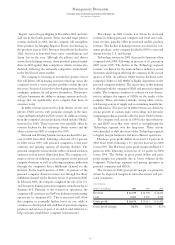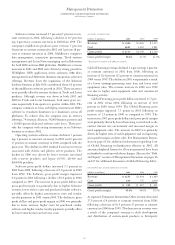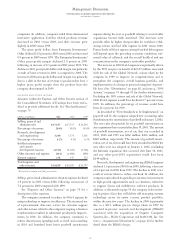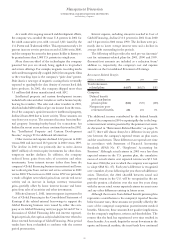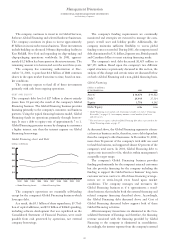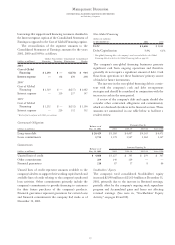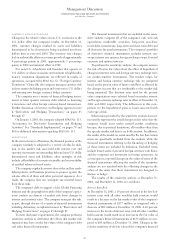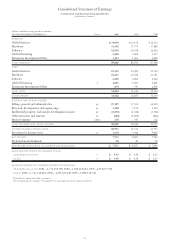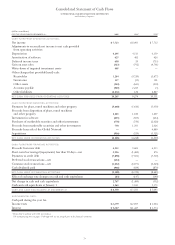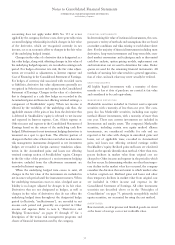IBM 2001 Annual Report Download - page 70
Download and view the complete annual report
Please find page 70 of the 2001 IBM annual report below. You can navigate through the pages in the report by either clicking on the pages listed below, or by using the keyword search tool below to find specific information within the annual report.
68
CURRENCY RATE FLUCTUATIONS
Changes in the relative values of non-U.S. currencies to the
U.S. dollar affect the company’s results. At December 31,
2001, currency changes resulted in assets and liabilities
denominated in local currencies being translated into fewer
dollars than at year-end 2000. The currency rate changes
had an unfavorable effect on revenue growth of approximately
4 percentage points in 2001, approximately 3 percentage
points in 2000 and minimal effect in 1999.
For non-U.S. subsidiaries and branches that operate in
U.S. dollars or whose economic environment is highly infla-
tionary, translation adjustments are reflected in results of
operations, as required by SFAS No. 52, “Foreign Currency
Tr anslation.” Generally, the company manages currency risk
in these entities by linking prices and contracts to U.S. dollars
and entering into foreign currency hedge contracts.
The company uses a variety of financial hedging instru-
ments to limit specific currency risks related to financing
transactions and other foreign currency-based transactions.
Further discussion of currency and hedging appears in note
k, “Derivatives and Hedging Transactions,” on pages 85
through 87.
On January 1, 2001, the company adopted SFAS No. 133,
“Accounting for Derivative Instruments and Hedging
Activities.” See “Standards Implemented,” on pages 79 and
80 for additional information regarding SFAS No. 133.
MARKET RISK
In the normal course of business, the financial position of the
company routinely is subjected to a variety of risks. In addi-
tion to the market risk associated with interest rate and
currency movements on outstanding debt and non-U.S. dollar
denominated assets and liabilities, other examples of risk
include collectibility of accounts receivable and recoverability
of residual values on leased assets.
The company regularly assesses these risks and has estab-
lished policies and business practices to protect against the
adverse effects of these and other potential exposures. As a
result, the company does not anticipate any material losses
from these risks.
The company’s debt in support of the Global Financing
business and the geographic breadth of the company’s opera-
tions contain an element of market risk from changes in
interest and currency rates. The company manages this risk,
in part, through the use of a variety of financial instruments
including derivatives, as explained in note k, “Derivatives and
Hedging Transactions,” on pages 85 through 87.
To meet disclosure requirements, the company performs
sensitivity analysis to determine the effects that market risk
exposures may have on the fair values of the company’s debt
and other financial instruments.
The financial instruments that are included in the sensi-
tivity analysis comprise all of the company’s cash and cash
equivalents, marketable securities, long-term non-lease
receivables, investments, long-term and short-term debt and
all derivative financial instruments. The company’s portfolio
of derivative financial instruments includes interest rate
swaps, interest rate options, foreign exchange swaps, forward
contracts and option contracts.
To perform the sensitivity analysis, the company assesses
the risk of loss in fair values from the effect of hypothetical
changes in interest rates and foreign currency exchange rates
on market-sensitive instruments. The market values for
interest and foreign currency exchange risk are computed
based on the present value of future cash flows as affected by
the changes in rates that are attributable to the market risk
being measured. The discount rates used for the present
value computations were selected based on market interest
and foreign currency exchange rates in effect at December 31,
2001 and 2000, respectively. The differences in this com-
parison are the hypothetical gains or losses associated with
each type of risk.
Information provided by the sensitivity analysis does not
necessarily represent the actual changes in fair value that the
company would incur under normal market conditions
because, due to practical limitations, all variables other than
the specific market risk factor are held constant. In addition,
the results of the model are constrained by the fact that certain
items are specifically excluded from the analysis, while the
financial instruments relating to the financing or hedging
of those items are included by definition. Excluded items
include leased assets, forecasted foreign currency cash flows,
and the company’s net investment in foreign operations. As
a consequence, reported changes in the values of some of the
financial instruments affecting the results of the sensitivity
analysis are not matched with the offsetting changes in the
values of the items that those instruments are designed to
finance or hedge.
The results of the sensitivity analysis at December 31,
2001, and December 31, 2000, are as follows:
Interest Rate Risk
At December 31, 2001, a 10 percent decrease in the levels of
interest rates with all other variables held constant would
result in a decrease in the fair market value of the company’s
financial instruments of $177 million as compared with a
decrease of $99 million at December 31, 2000. A 10 percent
increase in the levels of interest rates with all other variables
held constant would result in an increase in the fair value of
the company’s financial instruments of $151 million as com-
pared to $83 million at December 31, 2000. Changes in the
relative sensitivity of the fair value of the company’s financial
Management Discussion
INTERNATIONAL BUSINESS MACHINES CORPORATION
and Subsidiary Companies



